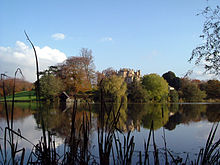Sherborne Castle
Sherborne Castle is a manor house southeast of Sherborne in the English county of Dorset . The house was built in the 16th century in the Tudor style. The 490 hectare park forms only a small part of the 61 km² land of the Barons Digby .
Sherborne Old Castle
Sherborne Old Castle is the ruin of a 12th century castle that sits on the manor's estate. The old castle was built as a fortress by Roger of Salisbury , Bishop of Salisbury and Lord Chancellor of England, and it was still in the hands of the church at the end of the 16th century.
Sherborne Lodge
After Sir Walter Raleigh had crossed Sherborne on his way to Plymouth , he fell in love with the castle and Elizabeth I requisitioned the property and made Sir Raleigh a fief in 1592. Raleigh did not have the old castle restored, but decided to have a new dwelling built for occasional visits, in the form for subordinate dwellings customary for the nobility at the time, often architecturally cultivated, which was then called "lodge". The new house, Sherborne Lodge , was a rectangular, four-story building that was completed in 1594. The historian John Aubrey remembers it as "a fine lodge in the park, built of bricks, not large but very appropriate for its size, a place to retreat from the courtyard for the summer, reflect, etc." It had four polygonal ones Corner towers with sloping masonry as if they had served military purposes. Nicholas Cooper says that "this should probably be a tribute to the old building". The most advanced detail at the time was the entrance, hidden in one of the corner towers as if not to disturb the apparent symmetry of the facade, which was centered on a rectangular forecourt. The vestibule also contained a spiral staircase and led directly to the great hall.
During Raleigh's imprisonment in the Tower of London , King James I gave the property to Robert Carr as a fief and sold it to Sir John Digby, 1st Earl of Bristol in 1617 . In the 1620s, the Digby family added four wings to the house to make the lodge a permanent home. The architectural style of the four wings corresponded to the original house and the four towers were preserved.
Sherborne New Castle
In the English Civil War Sherborne was tight royalist and General Fairfax by the Roundheads left in 1645 the old castle in ruins. The name "Sherborne Castle" was then used to designate the new house, even if it is more likely to be called "Sherborne New Castle" today, in contrast to the ruin, which is called "Sherborne Old Castle".
In the early and mid-18th centuries, William Digby, 5th Baron Digby , who planned the property that Alexander Pope so praised, and his heirs, Edward , who inherited in 1752, and Henry designed the castle gardens, including the lake, which are now visible. which was laid out by Capability Brown and separates the new and old castle. The ruins of the old castle are part of the gardens. They peek out from between the trees on the other side of the lake. King George III visited the house and gardens in 1789 just before he made Henry Digby, the 7th Baron, Earl. When Edward Digby, 2nd and last Earl Digby , died in 1856, the house fell to the Wingfield Digby family , who still own it today. The house was modernized by architect Philip Charles Hardwick .
During World War I , the mansion was used by the Red Cross as a hospital and during World War II as the headquarters of the commandos involved in Operation Neptune .
The gardens are open to the public for most of the year and the mansion can be toured most Saturdays. Special events are often held on the property, such as B. Concerts and fireworks performances. The old castle was rented from English Heritage and was separated from the gardens.
Individual evidence
- ↑ Janet Waymark: Sherborne, Dorset in Garden History . No. 29.1 (summer 2001). P. 65.
- ^ A b John Aubrey: Brief Lives: Sir Walter Raleigh , quoted by Nicholas Cooper in Houses of the Gentry 1480-1680 . 1999. p. 121.
- ↑ The contemporary floor plan by Simon Basil on plate 22 in Cooper's book shows with dashed lines that the inclined facades of the corner turrets ran parallel to the opposite inner corners.
- ↑ Although Lord Digby was sufficiently versed in architecture to be mentioned in Howard Colvin's A Biographical Dictionary of British Architects (3rd edition, 1995, entry: "Digby, William, 5th Lord Digby"), he did not leave any traces Sherborne
- ↑ Janet Waymark: Sherborne, Dorset in Garden History . No. 29.1 (summer 2001).
- ↑ A new library in the Gothic style was built by the London surveyor William Ride in the years 1757–1758, possibly also according to Ride's plan. ( Howard Colvin : A Biographical Dictionary of British Architects . 3rd Edition, 1995. Entry: "Ride, William").
swell
- Dorothy Brown: Capability Brown . 2nd revised edition. Faber and Faber, London 1975 (1950). ISBN 0-571-10267-0 ( ISBN 0-571-13405-X )
- Janet Waymark: Sherborne, Dorset in Garden History . No. 29.1 (summer 2001). Pp. 64-81.
Web links
- Sherborne Castle website
- Sherborne Castle Garden . Gardenvisit.com.
- Sherborne Old Castle . English Heritage.
Coordinates: 50 ° 56 '45.6 " N , 2 ° 30' 2.2" W.


